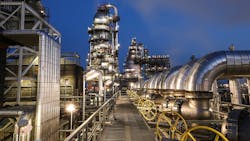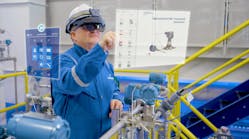Prevent industrial accidents by upgrading to brighter, safer LED lighting
Industrial accidents do not just happen. More often than not, they are caused by factors such as poor training and insufficient safeguarding. Unsafe lighting is another factor for an obvious reason: if an employee cannot see a hazard, accidents are bound to occur. Without proper lighting employees misjudge the position, shape or speed of objects. Small details are lost and colors are not what they appear to be.
"Unsafe lighting results in thousands of workplace injuries per year — such as falls, crushed body parts and forklift accidents — and virtually all of them could have been avoided," explained Ellen Helm, Director of Product Marketing for Emerson Automation Systems. "Glare, flickering or poor light distribution can also lead to eye irritation, dizziness, nausea and headaches."
Light quality basics
There are four factors used to judge lighting safety: illuminance, luminance, contrast and reflectance. If any of these four are sub-standard, lighting becomes a serious health hazard for employees.
- Illuminance refers to lighting being in the right direction and having the proper strength to aid workers. It is measured either in lux or lumens/square feet with the help of a light meter and taken from different angles and positions.
- Luminance is the amount of light being reflected from a surface, also known as candles per square feet. Several measurements are taken and then averaged. Usually, luminance tables are referred to check the values.
- Contrast indicates the relationship between the brightness of an object and its background. This too can be measured with the help of a luminance meter.
- Reflectance is the ratio of light falling on a particular surface to the amount of light getting reflected from a surface. Reflectance can be measured either with the help of a light meter or a reflectometer.
Testing for lighting quality in a facility doesn’t need to be complicated. To start, use a light meter to measure the average illumination throughout the workplace and compare it to the manufacturer’s recommended levels. Next, look for shadows, especially over work areas and on stairways. Finally, ask workers if they suffer from eye strain, headaches or are forced to squint to see. Now that you’ve identified the problems, it is time to fix it.
LED: The safe answer
Light emitting diode or “LED” technology has been increasingly installed in commercial and industrial sites over the past decade, including in hazardous locations such as oil refineries and chemical processing plants. LED technology is field-proven to yield superior light quality, improved energy efficiency and cost savings of 50% or more. However, the benefits of LED lighting don’t stop there, since installing LEDs in your facility can also create a safer environment. According to Emerson, here are seven ways how:
1. Fewer shadows
Dim, shadowed areas on the plant floor amplify chances for serious injuries. Quality LED’s brighten an entire area, create very little if any shadowing and maintain light levels far longer than high-intensity discharge (HID) fixtures. LED lumen output lasts 60,000 operating hours or longer — roughly seven years continuously — before the output is even modestly diminished. Even if older HID lighting is still working, it's likely operating at far less than its initial light output, which leads to dangerous shadows and dark spots. As HID lights age, more and more voltage is required to produce the same amount of light until eventually the voltage exceeds the fixed resistance provided by the ballast and the light fails.
2. True colors
The Color Rendering Index (CRI) is the method used by the lighting industry to measure the faithfulness of colors as they appear under different light sources. If a fixture has a low CRI rating, for example, objects will appear washed out by an orange-yellow glow. If the lighting source has a higher score on the index, however, colors will be more accurate and true.
Why is this important? When color rendering is inaccurate, tasks can be more difficult, such as the accurate assembly of components that require color discrimination or the quality inspection of a paint job. The majority of LED fixtures have CRI ratings of 70 or higher, meaning those workers in the illuminated area see a full range of colors in a clear, true and crisp manner. As a result, the space may also appear brighter even if the LED fixture has fewer lumens than the non-LED fixture it replaced, enabling the facility to benefit from both improved safety and increased energy efficiency.
3. Reduced maintenance
Because LED lighting is rugged and long-running, it requires much less maintenance when compared to HID or fluorescent fixtures. Less maintenance means no one will be required to regularly climb up and down high ladders. Plus, because LED is low-voltage, no one is going to be electrocuted changing a lamp. Conventional non-LED luminaires increase maintenance activities and costs. Due to their short life span, these light sources are changed frequently, which can put workers at risk, and interrupt standard work activities in a given room.
4. Attentive workers
Over the past decade, different studies have shown that LED lighting can positively affect people's perception of mental fatigue, behavior and performance. Being more alert aids workers in easily detecting the risk of slipping, falling or stumbling, thus reducing a large number of workplace accidents. Switching to LEDs has been also shown to increase the attention span, mood and performance of employees by as much as 25%. Cool-white LED light may also cause fewer instances of irritation, eye discomfort and headache.
5. Non-toxic materials
LED lighting is the only non-incandescent lighting source that contains no mercury. This eliminates any chance for mercury to escape into the environment either in operation or after disposal. Therefore, no special handling is required. Lights with lead-free solder ensure no toxins leach out when components finally reach end-of-life.
6. Instant-on
Once switched on, it can take Metal Halide fixtures up to 30 minutes to achieve full output. During that time, visibility is severely limited by the low light conditions and work can’t begin. For that reason, plant managers often leave Metal Halide fixtures on overnight. But why pay for light you don’t need? LEDs come on instantly with full visibility the second they are switched on. In fact, LEDs can be cycled on and off so efficiently that a motion sensor can activate them.
7. Better distribution
LED lighting is made of an array of hundreds of individual LED light chips with highly directed lensing. This prevents varying light levels that force eyes to readjust when moving from one level to the next. In areas where light is poorly distributed, workers will find it difficult or impossible to see properly. Worse yet, accidents and injuries from "momentary blindness" commonly occur while eyes adjust to brighter or darker surroundings. LED illumination is directed exactly where it needs to be and is not wasted pointing at the ceiling or spreading too thinly across a surface. This is an improvement over HID lights which are omnidirectional. Omnidirectional lights produce light in 360 degrees so at least half of the light needs to be reflected to the targeted area, making output much less efficient than LED.
"Safety is perhaps the most often overlooked advantage when it comes to LED lighting. An upgrade to LED lighting from incandescent, fluorescent or HID can improve overall vision and alertness as well as reduce dangerous shadowing and improve color recognition during industrial processes," said Helm. "While some building upgrades are effective in some properties and ineffective in others, upgrading to LED lighting is always a safe decision."
About EMERSON
Emerson (NYSE: EMR), headquartered in St. Louis, Missouri (USA), is a global technology and engineering company providing innovative solutions for customers in industrial, commercial, and residential markets. Our Emerson Automation Solutions business helps process, hybrid, and discrete manufacturers maximize production, protect personnel and the environment while optimizing their energy and operating costs. Our Emerson Commercial & Residential Solutions business helps ensure human comfort and health, protect food quality and safety, advance energy efficiency, and create sustainable infrastructure. For more information visit Emerson.com.


